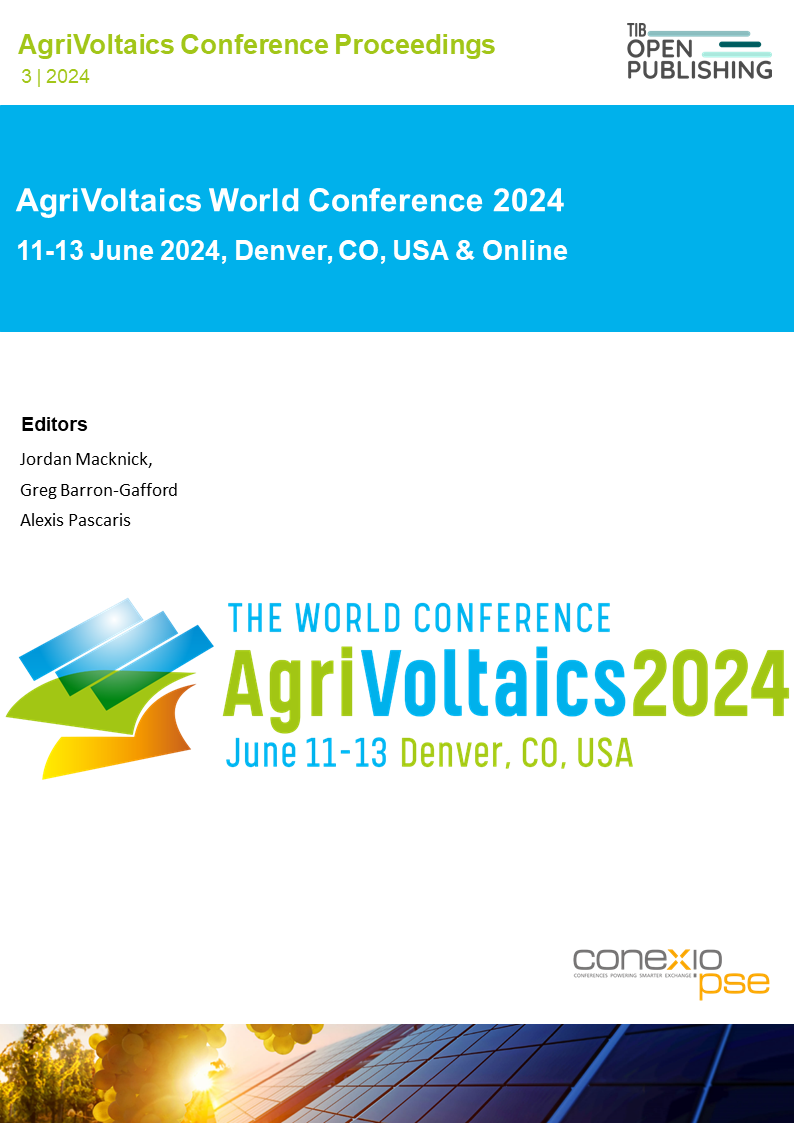A Simple Approach for Clustering Common Insolation Profiles in Agrivoltaic Systems
DOI:
https://doi.org/10.52825/agripv.v3i.1370Keywords:
Agrivoltaic System (AVS), AVS Layout Optimization, Livestock-Based AVS, K-Means Clustering, Land Equivalent RatioAbstract
Heterogeneous insolation distribution in agrivoltaic systems (AVS) impacts plant growth beneath solar panels via shading and perturbed evapotranspiration profiles. Most agricultural systems models, meanwhile, assume uniform irradiance patterns across an entire field when simulating biomass production, meaning that they cannot readily account for spatiotemporal trade-offs between agricultural production and energy generation pertaining to AVS. We develop a simple approach for enumerating trade-offs between crop/pasture production and energy generation that accounts for spatial heterogeneity in insolation that typifies most AVS fields. First, long-term spatially explicit daily insolation profiles at the ground surface are produced for several layouts, including variations in PV panel orientations, row spacings, heights and tilt angles. A clustering technique was then applied to all insolation profiles to group them into rationally bounded cluster groups. The insolation profile of each cluster group was set as an input to a conventional point-based agricultural systems model to determine agricultural production under heterogeneous insolation profiles. The proposed approach is applied to a case study near Hobart, Australia, to determine an optimal layout that maximizes energy generation and plant growth associated with 81 AVS layouts. We find a manageable number (19 clusters) of point-based agricultural model scenarios capture much of the variance in insolation variability associated with varying AVS layouts. Compared with open fields, we show that AVS can amplify pasture growth rates during late spring and early summer. The optimal layout for our case study region enhanced land productivity by 47% while maintaining 80% of agricultural production compared with open-field agriculture.
Downloads
References
C. Dupraz, H. Marrou, G. Talbot, L. Dufour, A. Nogier, Y. Ferard, "Combining solar photo-voltaic panels and food crops for optimising land use: Towards new agrivoltaic schemes," Renewable Energy, vol. 36, no. 10, pp. 2725-2732, 2011/10/01/ 2011, doi: https://doi.org/10.1016/j.renene.2011.03.005.
I. A. Ramos-Fuentes, Y. Elamri, B. Cheviron, C. Dejean, G. Belaud, D. Fumey, "Effects of shade and deficit irrigation on maize growth and development in fixed and dynamic AgriVoltaic systems," Agricultural Water Management, vol. 280, p. 108187, 2023, doi: https://doi.org/10.1016/j.agwat.2023.108187.
S. Amaducci, X. Yin, M. Colauzzi, "Agrivoltaic systems to optimise land use for electric energy production," Applied Energy, vol. 220, pp. 545-561, 2018/06/15/ 2018, doi: https://doi.org/10.1016/j.apenergy.2018.03.081.
R. I. Cuppari, C. W. Higgins, G. W. Characklis, "Agrivoltaics and weather risk: A diversifi-cation strategy for landowners," Applied Energy, vol. 291, p. 116809, 2021, doi: https://doi.org/10.1016/j.apenergy.2021.116809.
R. Handler, J. M. Pearce, "Greener sheep: Life cycle analysis of integrated sheep agri-voltaic systems," Cleaner Energy Systems, vol. 3, p. 100036, 2022, doi: https://doi.org/10.1016/j.cles.2022.100036.
A. S. C. Maia, E. de Andrade Culhari, V. d. F. C. Fonsêca, H. F. M. Milan, K. G. Ge-bremedhin, "Photovoltaic panels as shading resources for livestock," Journal of Cleaner Production, vol. 258, p. 120551, 2020, doi: https://doi.org/10.1016/j.jclepro.2020.120551.
M. Laub, L. Pataczek, A. Feuerbacher, S. Zikeli, P. Högy, "Contrasting yield responses at varying levels of shade suggest different suitability of crops for dual land-use systems: a meta-analysis," Agronomy for Sustainable Development, vol. 42, no. 3, p. 51, 2022, doi: https://doi.org/10.1007/s13593-022-00783-7.
S. Gorjian, E. Bousi, Ö. E. Özdemir, M. Trommsdorff, N. M. Kumar, A. Anand, K. Kant, S. S. Chopra, "Progress and challenges of crop production and electricity generation in agrivoltaic systems using semi-transparent photovoltaic technology," Renewable and Sus-tainable Energy Reviews, vol. 158, p. 112126, 2022, doi: https://doi.org/10.1016/j.rser.2022.112126.
C. Toledo, A. Scognamiglio, "Agrivoltaic systems design and assessment: A critical re-view, and a descriptive model towards a sustainable landscape vision (three-dimensional agrivoltaic patterns)," Sustainability, vol. 13, no. 12, p. 6871, 2021, doi: https://doi.org/10.3390/su13126871.
H. Dinesh, J. M. Pearce, "The potential of agrivoltaic systems," Renewable and Sustaina-ble Energy Reviews, vol. 54, pp. 299-308, 2016/02/01/ 2016, doi: https://doi.org/10.1016/j.rser.2015.10.024.
System Advisor Model (SAM) Version 2022.11.21. National Renewable Energy Labora-tory. Golden, CO. Accessed: 2-March 2023. [Online]. Available: https://sam.nrel.gov/
B. Valle, T. Simonneau, F. Sourd, P. Pechier, P. Hamard, T. Frisson, M. Ryckewaert, A. Christophe, "Increasing the total productivity of a land by combining mobile photovoltaic panels and food crops," Applied energy, vol. 206, pp. 1495-1507, 2017.
S. Kim, Y. Kim, Y. On, J. So, C.-Y. Yoon, S. Kim, "Hybrid performance modeling of an agrophotovoltaic system in South Korea," Energies, vol. 15, no. 18, p. 6512, 2022, doi: https://doi.org/10.3390/en15186512.
P. E. Campana, B. Stridh, S. Amaducci, M. Colauzzi, "Optimisation of vertically mounted agrivoltaic systems," Journal of Cleaner Production, vol. 325, p. 129091, 2021/11/20/ 2021, doi: https://doi.org/10.1016/j.jclepro.2021.129091.
M. S. Ahmed, M. R. Khan, A. Haque, M. R. Khan, "Agrivoltaics analysis in a techno-economic framework: Understanding why agrivoltaics on rice will always be profitable," Applied Energy, vol. 323, p. 119560, 2022, doi: https://doi.org/10.1016/j.apenergy.2022.119560.
M. Silva, J. J. Roberts, P. O. Prado, "Calculation of the shading factors for solar modules with matlab," Energies, vol. 14, no. 15, p. 4713, 2021, doi: https://doi.org/10.3390/en14154713.
I. Reda, A. Andreas, "Solar position algorithm for solar radiation applications," Solar ener-gy, vol. 76, no. 5, pp. 577-589, 2004, doi: https://doi.org/10.1016/j.solener.2003.12.003.
The MathWorks Inc., MATLAB version: 9.11 (R2021b), Accessed: January 14, 2023 2021. [Online]. Available: https://www.mathworks.com.
National Renewable Energy Laboratory (NREL). NSRDB: National Solar Radiation Data-base. [Online]. Available: https://nsrdb.nrel.gov/data-viewer
GrassGro®, Commonwealth Scientific and Industrial Research Organisation (CSIRO). [Online]. Available: https://grazplan.csiro.au/grassgro/.
F. Bilotto, K. M. Christie-Whitehead, B. Malcolm, M. T. Harrison, "Carbon, cash, cattle and the climate crisis," Sustainability Science, pp. 1-17, 2023, doi: https://doi.org/10.1007/s11625-023-01323-2.
M. Graham, S. Ates, A. P. Melathopoulos, A. R. Moldenke, S. J. DeBano, L. R. Best, C. W. Higgins, "Partial shading by solar panels delays bloom, increases floral abundance dur-ing the late-season for pollinators in a dryland, agrivoltaic ecosystem," Scientific reports, vol. 11, no. 1, pp. 1-13, 2021, doi: https://doi.org/10.1038/s41598-021-86756-4.
Published
How to Cite
Conference Proceedings Volume
Section
License
Copyright (c) 2025 Ganesh Pandey, Sarah Lyden, Evan Franklin , Matthew Tom Harrison

This work is licensed under a Creative Commons Attribution 4.0 International License.
Accepted 2025-03-05
Published 2025-04-29
